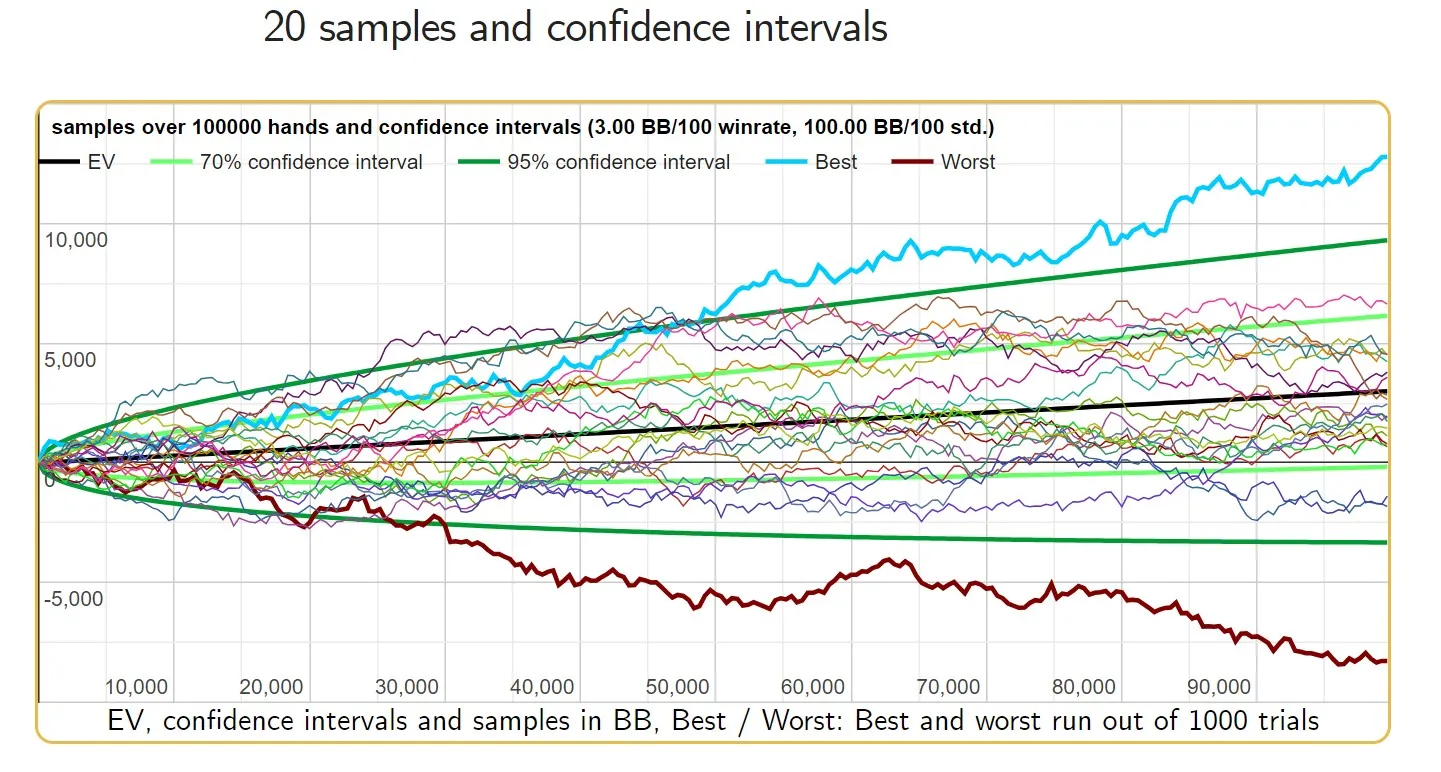Keeping a Level Head During Bad Variance

Mar 21, 2025
•
2 min read
The only constant in life is change.
- Heraclitus
Welcome back! Our previous instalment left off discussing the importance of executing a consistent strategy, but we know poker’s anything but consistent!
Poker variance obscures the big picture by delivering it in bits, that is, one hand at a time.
So, how do professional poker players conquer poker variance and play confidently when everything feels like it’s blowing up? Keep reading to find out!
What is Poker Variance?
Poker variance is the natural fluctuations in a player's results over the short term, because of the inherent randomness of the game.
Imagine a drawing of a few black dots and ovals on a white background. If it’s in full screen, millions of pixels either light up to turn white or stay off to remain black to display the whole image:

If you were to turn on each pixel one at a time like a screen does, row by row, BUT at the speed of one pixel per one hand of poker, the times you just leave the pixel off might seem like they never end, even though that won’t make most of the journey. We perceive poker variance this way.
More importantly, when we’re not seeing the results we expect after putting in work off the felt due to patches of variance, we might question our strategy or simply tilt, resulting in unprofitable decisions!
If you are serious about playing poker, you will go through downswings so long and brutal it’s hard to believe. - Jonathan Little
What Causes Variance in Poker?
The cause of variance in poker is simply nature: it’s been here since the beginning of time, like the speed of light, gravity, and all the laws of physics. This is why, in order to succeed in poker, you must embrace the variance!
But… “how do you avoid variance in poker?” - You don’t: You come to terms with how variance affects the game, particularly your mental game as well as that of your opponents. The end goal, after all, is more consistency for us and less for our villains.
Remember, when we’re thrown off our strategy, we’re much more likely to make negative EV decisions than +EV decisions. Also, as discussed in the previous installment, consistent strategy can be measured!
So, what practical steps do professionals take to deal with variance in poker? Read on and find out!
How to Deal With Variance in Poker [5 Tips From the Pros]
Here are 5 tips to help you manage variance in poker like a professional:
- Track your win-rate. Every poker strategy has a win-rate, which you can visualize as a line on a graph showing big blinds won over time. A flat line means breaking even, while a winning player's line slopes upward. The steeper the slope, the higher the win-rate (measured in big blinds per 100 hands).
- Leverage tools. Use a poker variance calculator (like “primedope.com”) to estimate variance. Input your win-rate and standard deviation to get an idea of the swings you might experience.
- Be realistic. While top players may have win-rates over 10bb/100, most profitable online players fall within the 1-6bb/100 range.
- Understand different formats. Standard deviation varies by format: 6-max PLO games have high variance (up to 180bb/100); while Full-ring NLHE has lower variance (around 70-80bb/100).
- Play the easiest format by variance. Full-ring (9-max) Texas Hold'em cash games have the least variance. In contrast, 6-max--the most popular online format--has a standard deviation between 90-110bb/100 for most winning strategies.

What to Expect?
By inputting test win-rates and the standard deviation for 6-max Hold’em into a poker variance calculator, you can get a clear idea of what to expect. You'll understand how much you might lose during your worst downswings and how long break-even stretches could last.
Let’s take a look at how different win-rates affect the variance you might face:
| Win-Rate | Maximum Expected Drop | Maximum Break-Even Stretch |
|---|---|---|
| 3bb/100 | Over 10,000 big blinds | Over 500,000 hands |
| 4bb/100 | Over 7,500 big blinds | Over 300,000 hands |
| 5bb/100 | Over 5,000 big blinds | Over 200,000 hands |
While these extreme scenarios are rare, once you start playing at a professional volume, you should be prepared for one of these tough stretches.
Keep in mind, these are just estimates. Until you've logged between 50,000 and 150,000 hands yourself, you can't accurately assess your average win-rate. It might even be lower, leading to more turbulence. Additionally, the emotional impact of downswings--like tilt, even in small doses--can reduce your win-rate further during rough patches, adding to the challenge.
We may not be able to eliminate variance but we can certainly change how variance is felt. - Upswing Poker
So, what can you do when you’re losing coin-flip all-ins, getting sucked out on constantly, missing your draws, running into value hands, and having your bluffs repeatedly called? Let’s see…
The Musts of Keeping a Level Head
1. Proper Bankroll
We'll dive deeper into this topic later, but for now, know this: the financial hits you take during downswings should never cause you to worry about your finances. You need to execute your strategy without the fear of losing money.
Successful grinders often move between stakes. While our egos may resist, smart players drop down in stakes when necessary. Let the bad regs go bust--you're here to take advantage of scared money, not become it.
2. Slow Things Down
Volume is important, but save it for when you're running hot. When you're not, consider playing fewer tables than usual--maybe even just one. Not forever, but for a short while. Reducing the number of tables gives you more mental bandwidth, lowering stress and reducing tilt.
Playing four tables at 5bb/100 beats playing ten tables at 0.5bb/100. By slowing down and thinking through each decision, you’ll make sure you're bringing your A-game, even when variance is against you.
3. Review and Study
When variance throws you off, studying and reviewing hands can help rebuild your confidence for the next session. Use your hand-history tracker and equity calculator. Seek input on your strategy from trusted friends or forums.
Remember, the everyday situations that generate most of your profits aren’t always as thrilling as that tough river all-in spot where you had the third nuts and got check-raised for 300 big blinds.
Focus on common scenarios, like c-betting or defending against it. It might seem less exciting, but that's where the real money is.
Conclusion
To sum up, poker variance is an inevitable part of the game, driven by probability. While we can’t predict individual sessions, long-term success is achievable with a consistent +EV strategy, and we can anticipate the swings that come with it.
Letting negative variance affect you can lead to poor decisions with negative expected value, making things worse. By accepting that variance is unavoidable and sometimes extreme, you’ll keep perspective when facing losses. Proper bankroll management is crucial--losing a few buy-ins shouldn't feel like a financial hit. Scared money doesn’t win, and fear-based decisions hurt your game.
During tough stretches, focus on making thoughtful plays. Reduce the number of tables and spend more time reviewing your game off the felt. Downswings eventually end, and your preparation will help you crush when you start running hot again.
When things get rough, remember: the next upswing is always, ALWAYS, just around the corner!
ZOOM IN
The following links are recommended resources related to this section’s theme. Don’t stay in doubt--dive in! 🔔
- Variance calculator: We recommend you to try with “primedope.com”.
- Database tracking software: You may want to check PokerTracker 4 and Holdem Manager 3.
- Equity calculator: We recommend you to try Power Equilab.
- Tilt: Learn how to avoid tilt in poker.
- Discord Community: Join the coolest poker community, don’t be shy! Use it to ask questions and interact with other poker enthusiasts and professionals.